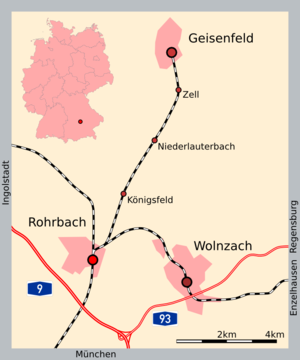Wolnzach – Geisenfeld railway line
| Wolnzach train station-Geisenfeld | |||||||||||||||||||||||||||||||||||||
|---|---|---|---|---|---|---|---|---|---|---|---|---|---|---|---|---|---|---|---|---|---|---|---|---|---|---|---|---|---|---|---|---|---|---|---|---|---|
| Route number : | 5384 | ||||||||||||||||||||||||||||||||||||
| Course book range : | 413h (1944) | ||||||||||||||||||||||||||||||||||||
| Route length: | 9.34 km | ||||||||||||||||||||||||||||||||||||
| Gauge : | 1435 mm ( standard gauge ) | ||||||||||||||||||||||||||||||||||||
| Route class : | A. | ||||||||||||||||||||||||||||||||||||
| Maximum slope : | 15 ‰ | ||||||||||||||||||||||||||||||||||||
| Minimum radius : | 200 m | ||||||||||||||||||||||||||||||||||||
| Top speed: | 50 km / h | ||||||||||||||||||||||||||||||||||||
|
|||||||||||||||||||||||||||||||||||||
The Wolnzach Bahnhof – Geisenfeld railway was a branch line in the Hallertau hop region in northern Upper Bavaria . The route was popularly known as the Geisenfelder Bockerl . Occasionally, due to its geographical and historical proximity, it is counted as the third branch in the network of the Hallertau Local Railway , but was largely operationally independent.
history
After the Geisenfeld market had been neglected in various national railway construction projects since 1861, they wanted to follow the example of Mainburg , which by the end of 1895 was connected by a local train to Wolnzach Bahnhof (renamed Rohrbach (Ilm) in 2000) to the Munich – Ingolstadt railway line . The planning for this began a year later. After further delays, the Bavarian Local Railway Act of August 10, 1904 approved the construction of a local railway from Wolnzach Bahnhof to Geisenfeld. In April 1906, construction work on the short stretch began. It ran from Wolnzach train station about a kilometer parallel to the Mainburg route and then followed the flat Ilm valley until it reached the final station Geisenfeld after a total of nine kilometers.
On December 15, 1906, the Royal Bavarian State Railways officially opened the line after a short construction period. In the early days, the ML 2/2 and PtL 2/2 (class 98 3 ) local railway locomotives, which were specially developed for simple operating conditions, were used on the line . Since both local railways had only one platform in Wolnzach Bahnhof, the train to Geisenfeld was usually provided on the same track behind the Mainburg train and ran about five minutes later. For many years, three to four pairs of trains usually ran each day. They only ran the third, and between 1918 and 1928 only the fourth class of car, which was temporarily introduced in Bavaria.
At the end of 1923 the Deutsche Reichsbahn temporarily closed the stops in Zell and Burgstall as a result of economic problems caused by hyperinflation , the latter permanently. As early as the 1930s, the line was threatened with closure for the first time, as many passengers migrated after the establishment of a direct private bus line Ingolstadt-Geisenfeld-Mainburg. In 1944/45 the train service was temporarily replaced by a bus. The line remained almost undamaged in World War II, but was used to park locomotives and wagons from Ingolstadt, some of which were badly damaged.
After the Second World War, a locomotive of the former class Pt 2/3 (class 70 0 ) was used and the timetable was expanded to eight pairs of trains a day in the early 1950s. The switch to modern rail buses did not take place any longer. On December 1, 1953, passenger train traffic between Wolnzach Bahnhof and Geisenfeld was the first to be stopped on a Bavarian railway line for economic reasons, apart from routes that were interrupted by the division of Germany . Instead, the young German Federal Railroad now permanently used a rail bus on the almost parallel state road , the journeys of which were recorded in the timetable as a rail route for years.
The route continued to be used for freight traffic, but because of the flat route, the Köf stationed in Wolnzach Bahnhof was used, after which, from around 1982, a class 211 diesel locomotive from the Augsburg depot was used. Because of the poor superstructure, the heavy machines of the 290 series , which served the line to Mainburg , could not be used. Since the condition of the line continued to deteriorate in the 1980s, freight traffic was discontinued on December 31, 1987 and the line was formally closed on March 31, 1988 and dismantled that same year. The former station area and the track in the Geisenfeld urban area are now largely built over.
Individual evidence
- ↑ a b Wolfram Alteneder, Clemens Schüssler: The branch lines of the BD Munich . Verlag C. Kersting, Bonn 1987, ISBN 3-925250-03-4 , p. 38 .
- ↑ Steffen Lüdecke: The 98 series . tape 1 . EK-Verlag, Freiburg 1999, ISBN 3-88255-135-6 , p. 92, 105 .
- ↑ Steffen Lüdecke (Ed.): Narrated Railway . EK-Verlag, Freiburg 2006, ISBN 3-88255-801-6 , p. 205 .
- ^ The Rohrbach (Ilm) - Wolnzach railway line. Hallertauer Lokalbahnverein eV, accessed on May 26, 2020 .
- ^ Armin Franzke: Wolnzach train station - Geisenfeld . In: Secondary and narrow-gauge railways in Germany then and now . GeraMond, Munich 2004.
- ↑ Andreas Knipping: The 70 series . EK-Verlag, Freiburg 1998, ISBN 3-88255-170-4 , p. 175, 182 .
- ^ Deutsche Bundesbahn (Ed.): Course books, pocket timetables . (various years).
- ↑ Train bus instead of local train. Hallertauer Lokalbahnverein eV, accessed on May 26, 2020 .
- ↑ Alois Graßl: Numbers and data on bockerl.de, accessed on May 13, 2018.
